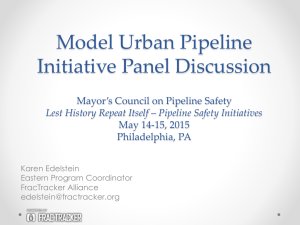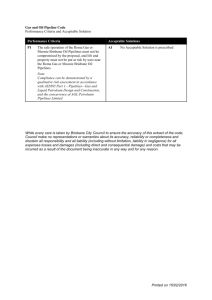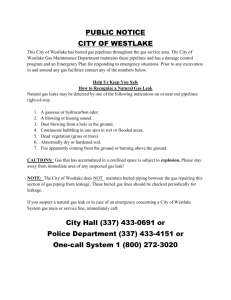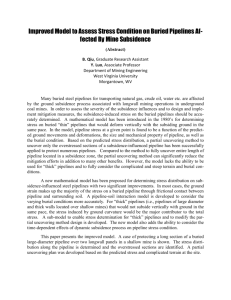Leak Detection in Oil & Gas Pipelines: Dissertation Intro
advertisement
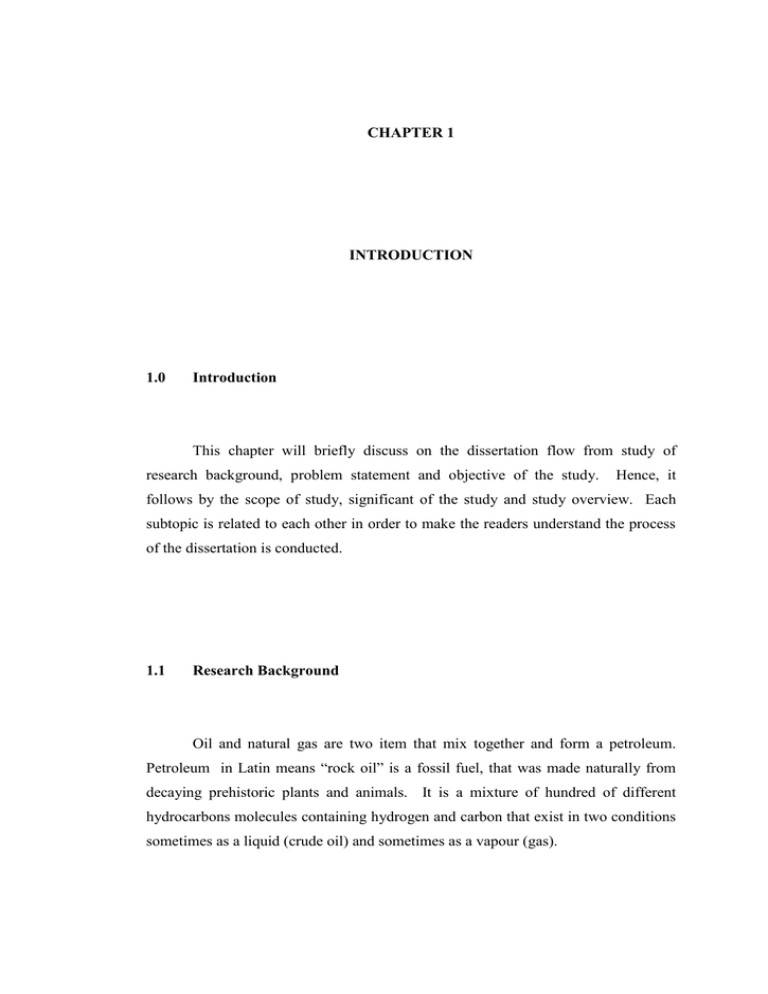
CHAPTER 1 INTRODUCTION 1.0 Introduction This chapter will briefly discuss on the dissertation flow from study of research background, problem statement and objective of the study. Hence, it follows by the scope of study, significant of the study and study overview. Each subtopic is related to each other in order to make the readers understand the process of the dissertation is conducted. 1.1 Research Background Oil and natural gas are two item that mix together and form a petroleum. Petroleum in Latin means “rock oil” is a fossil fuel, that was made naturally from decaying prehistoric plants and animals. It is a mixture of hundred of different hydrocarbons molecules containing hydrogen and carbon that exist in two conditions sometimes as a liquid (crude oil) and sometimes as a vapour (gas). 2 Crude oil and natural gas are found throughout the world, beneath both land and sea, as follows: Western Hemisphere Intercontinental Basin (US Gulf Coast, Mexico, Venezuela) Middle East (Arabian Peninsula, Persian Gulf, Black and Caspian Seas) Indonesia and South China Sea North and West Africa (Sahara and Nigeria) North America (Alaska, Newfoundland, California and Mid-continent United States and Canada) Far East (Siberia and China) North Sea. Natural gas is most probably can be found near petroleum field. The oil is then being transported to refineries and distilled into fuel or any base chemical products. While for natural gas, it is pumped from below ground and travels in pipelines. It is difficult to transport the natural gas across long distances. In most countries, the best action to be taken is to consume the natural gas within the country or exported to a neighbouring country by pipeline. Another alternative is by using the technology for liquefying natural gas so that it can be transported in tankers (like oil) is improving, but the volume of natural gas exported in this manner is still limited. As technology expands the options for gas transportation, demand for natural gas is expected to grow. Transportation pipelines, mainly long pipes with large diameters, moving products (oil, gas, refined products) between cities, countries and even continents. These transportation networks include several compressor stations in gas lines or pump stations for crude and multi-products pipelines. Usually, oil pipelines are made from steel or plastic tubes with inner diameter typically from 4 to 48 inches (100 to 1,220 mm). Most pipelines are typically buried at a depth of about 3 to 6 feet (0.91 to 1.83 m). To protect pipes from impact, abrasion, and corrosion, a variety of methods are used. These can include wood lagging (wood slats), concrete coating, 3 rock shield, high-density polyethylene, imported sand padding, and padding machines. For natural gas, pipelines are constructed of carbon steel and vary in size from 2 to 60 inches (51 to 1,524 mm) in diameter, depending on the type of pipeline. There are many factors that will give a big impact to the pipelines transportation. In oil and gas industry, some of the problem that could occur in the pipeline is heat exchangers and fouling in oil refineries, corrosion, inhomogeneous mixture and also leakage. Leaks in pipelines (Figure 1.1) and major accidents can occur, but are extremely rare situation. Leakage is a process in which material is gradually lost, intentionally or accidentally, through the holes or defects of their containers. Figure 1.1 : Examples of leakage occurring through the pipeline. The cause of leakage of fluid especially in pipelines occurs in a number of reasons such as fatigue crack. Fatigue is the progressive and localized structural damage that occurs when a material is subjected to cyclic loading. They manifest themselves as internal or external surface cracks that usually occur in the vicinity of longitudinal welds. Stress of corrosion is an external tension crack causes localised damage to the cathodic corrosion protection, resulting in corrosion in the area. Corrosion is the gradual destruction of material, usually metals, by chemical reaction with its environment. Another reason that can causes leakage is hydrogen induction. In this case, atomic hydrogen diffuses in to the metal matrix of the pipeline, resulting in the embrittlement of the metal. Material failure, for example the rolling in of 4 cavities during manufacture and internal influences that include earthwork and subsidence caused by mining activities also can cause leaks. 1.2 Problem Statement Leakage in oil and gas pipelines can potentially cause of the losses of production, environment pollution and human safety, as well as economic loss. The effects of the damage that cause by oil and gas leaks to necessitates the development of efficient leak detection systems. However, it is difficult to detect any problem that could occur in the pipeline flow with the naked eyes. Therefore, to overcome this situations, there are many methods and techniques are being proposed. Several methods have been developed to detect the leakage of oil and gas in pipeline such as hardware based methods, non-technical methods and software based method. The software-based methods that work for cases with limited instrumentation being considered as the motivations for this study. The leak detection model will be governed by a mathematical model. Based on the situation when once the leak is detected, the plant is start to shutting down the pipelines. At this moment the major problem of oil and gas production is to monitor the leakage of the fluid in pipeline. Therefore this study will explore the following question: • Can the leak detection system be improved under time-varying boundary conditions. 5 1.3 Objectives Of The Study The objective of this study are : 1. To formulate the model of leak with friction 2. To formulate the observer model of leak with friction 3. To discretize the governing equation of the model using Finite Difference Method 4. 1.4 To develop the algorithm for leak detection method Scope Of The Study The scope of this research are stated as the following : 1. Worked is based on the paper written by Espen Hauge et. al (2007) entitled “Model Based Pipeline Monitoring With Leak Detection”. 2. One-dimensional compressible flow described by time dependent continuity and momentum equations. 1.5 Significance Of The Study This study should help the oil and gas productions to detect and locate the leakage more precisely and efficiently. Hence, it could give a great impact for economical and safety operation in this industry. 6 Figure 1.2 : View of the fire in San Bruno, California There are several cases that involved pipelines and one of it, is San Bruno pipeline explosion in 9 September 2010 (Figure 1.2). San Bruno, California is a suburb of San Francisco, when a 30 inch (76 cm) diameter steel natural gas pipeline owned by Pacific Gas & Electric exploded in flames in the Crestmoor residential neighbourhood, 2 miles west of San Francisco International Airport near Skyline Boulevard and San Bruno Avenue. The explosion excavated an asymmetric crater 167 feet (51 m) long, 26 feet (7.9 m) wide and 40 feet (12 m) deep along the sidewalk of Glenview Drive. Figure 1.3:Destruction after fire and explosion in San Bruno 7 The effect of the explosion is 38 of the houses damaged and 8 people death (Figure 1.3). Throughout the investigation that had been done by the National Transportation Safety Board, they found that the cause of the explosion is leakage on the pipeline. This disaster gave the great impact to the country. Malaysia is one of the country that produce petroleum and natural gas (Figure 1.4). Based on the official website of Malaysian Investment Development Authority, Malaysia has the world’s 14th largest natural gas reserves and the 23rd largest crude oil reserves. Currently, Malaysia produced 2000 million standard cubic feet per day of natural gas and 730000 barrels of oil equivalent per day of crude oil. Malaysia also has the world largest production facility at a single location of liquefied natural gas with production capacity of 24.2 million metric tonne per year. Figure1. 4: Map of countries that produce oil and gas in the world In the petroleum and natural gas industries, a lots of pipelines are used here to transfer oil and gas from one place to another. Therefore, Malaysia should prepare for a variety of possibilities, particularly related to the leakage of the oil and gas pipelines. The management of leakage problem should get more attention and 8 prioritized by the player in the industries to prevent from the high impact explosions caused by pipeline leakage. Thus, early detection of pipelines leakage will help to save the whole country form disaster and also prevent from economic loss. 1.6 Outline Of Dissertation This report contains six chapter including introduction chapter in Chapter 1. The research background, problem statement, objective of the study, the scope of the study and the significance of the study will be discussed in this chapter. The literature review of this study is discussed in the next chapter, Chapter 2. All previous studies or research that has been done and related with the current project is assembled in this chapter, including the theories, models, method and figures that may support this project. The dissertation’s methodology that describe the method or approach that is used to solve the problem given will be discussed in Chapter 3. The derivation of the governing equations for the leak in pipelines is shown in this chapter. Chapter 4 is to discuss the solution procedure. The procedure that will be used to analyze and to get the solutions for the model proposed in the previous chapter will be shown and use to obtain result in the next chapter using the appropriate mathematical package. 9 Chapter 5 is to discuss the result and discussion. The solutions from previous chapter will be used to analyze the problem proposed. All results and graph will be shown and attached in this chapter. The last chapter is Chapter 6 the conclusion and recommendations. This chapter will be concluded with a summary after the whole project is completed. It also contains some suggestions for future studies.
